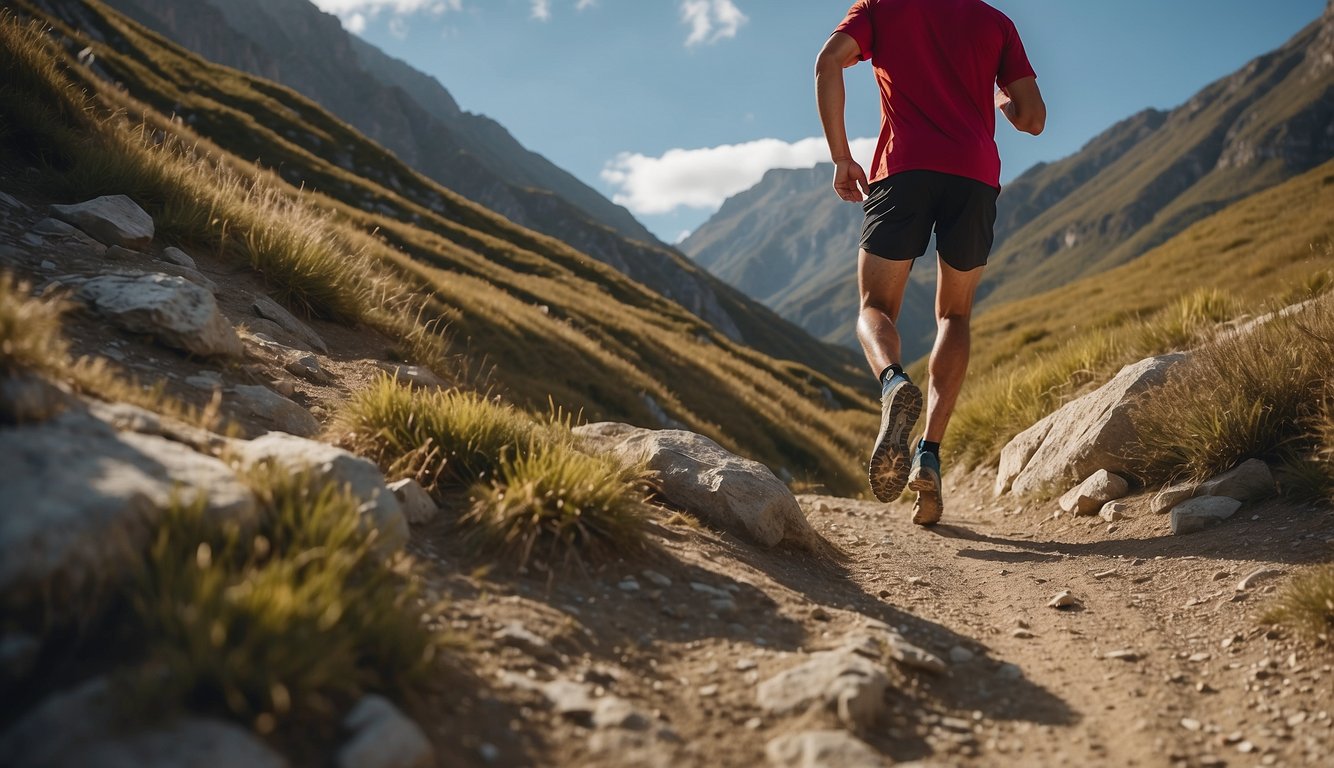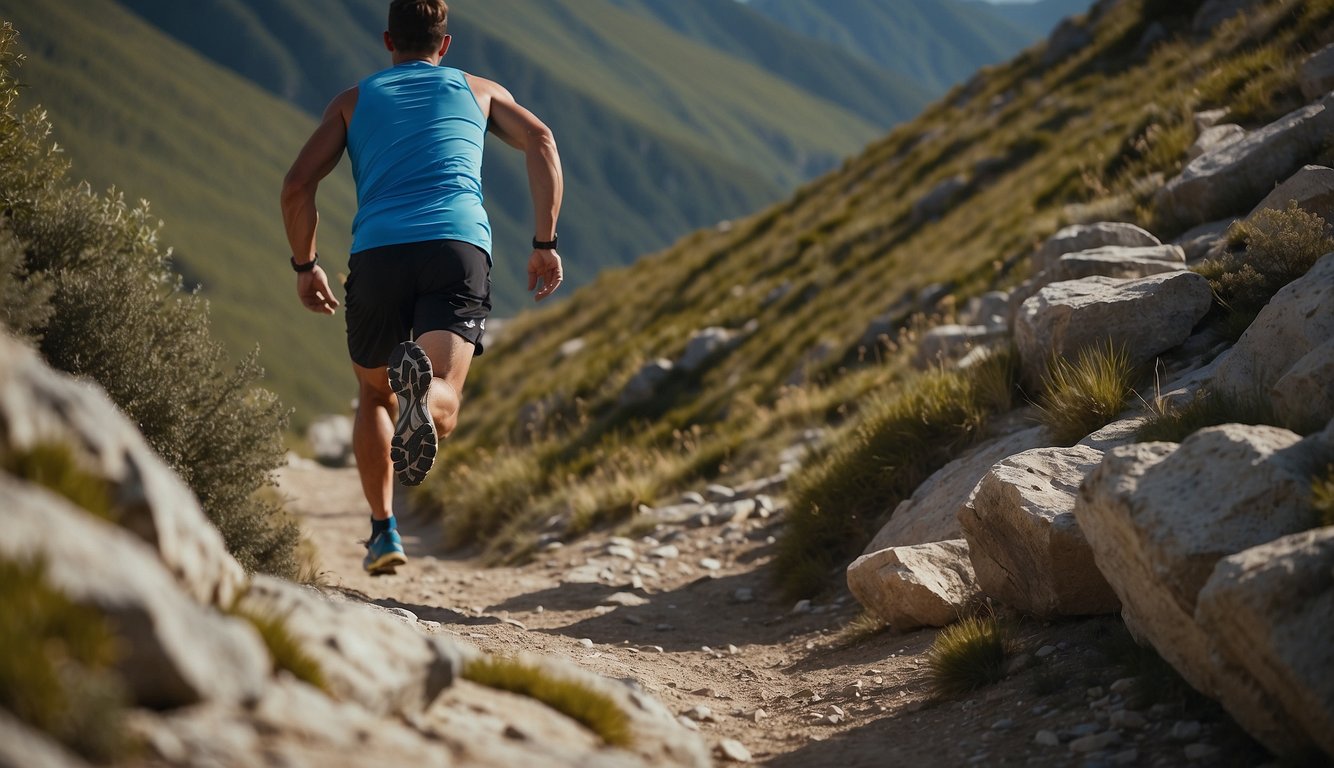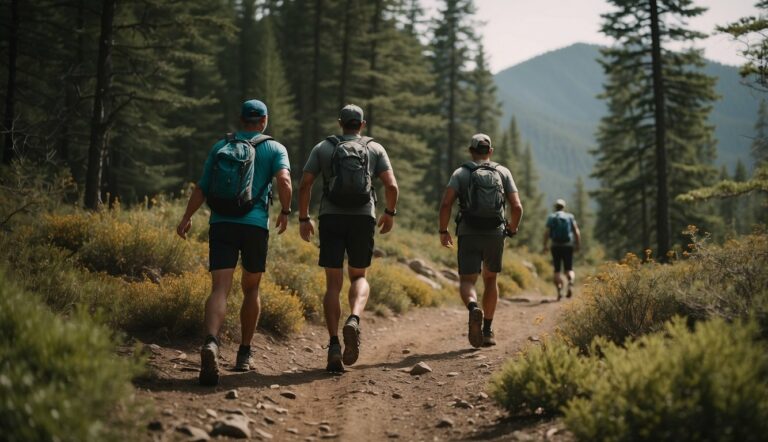The Art of Downhill Running for Trail Runners: Techniques for Speedy and Secure Descents
Downhill running is an exhilarating part of trail running that requires its own set of techniques to be both fast and safe. As an experienced UESCA certified running coach, I’ve helped countless runners improve their downhill performance. A crucial aspect of efficient downhill running is a strong core and lower body strength, which help maintain control and stability.
Proper technique is paramount to prevent injuries and increase speed when taking on a descent. Landing on your midfoot offers the best balance and control, allowing for a quick response to the terrain. Keeping your arms bent and letting them swing naturally aids in balance, while looking ahead helps anticipate and navigate the terrain with confidence.
Incorporating specific training for downhill sections, such as practicing eccentric contractions, can greatly enhance your ability to run downhill more effectively. This approach minimizes muscle damage and improves your ability to tackle steep descents without compromising your form. Remember, a controlled and practiced descent can be just as strategic as a well-paced ascent.
Fundamentals of Downhill Running for Trail Runners
Downhill running, when done correctly, harnesses gravity to enhance your running efficiency. Good form and understanding impact forces are vital for a fast, yet controlled descent.
Embracing Gravity for Efficient Descent
Gravity is a runner’s ally on downhills. I advise runners to lean slightly forward from their ankles, not their waist, which allows gravity to help with the descent. This slight lean, paired with a controlled pace, can make the descent smoother and more efficient.
- Lean: Slight, from ankles
- Effect: Utilizes gravity for better descent control
Importance of Proper Form
The right form during downhill running minimizes the risk of injury and improves control. I teach runners to maintain a shorter stride and quick cadence to react to the varied terrain rapidly. Keeping your knees soft and your gaze ahead, rather than down at your feet, helps maintain balance and anticipate changes in the path.
- Stride: Shorter
- Cadence: Quick
- Posture: Upright with a soft gaze forward
Understanding Impact Forces
Running downhill increases the impact on your legs compared to flat or uphill running. To manage this, I recommend focusing on light, soft steps and a balanced posture to distribute the force impact across your legs more evenly. Absorbing the impact with your muscles, rather than your joints, can reduce the risk of injury.
- Steps: Light and soft
- Distribution of Force: Even, across the leg muscles
- Muscle Use: Active absorption to protect joints
Mastering Balance and Coordination

In downhill running, maintaining balance and coordination is paramount for speed and safety. Effective techniques focus on utilizing core stability, precise foot placement, and strategic arm and leg movements.
Core Stability and Foot Placement
Core stability serves as the anchor for balance when navigating downhill terrain. Engaging my core helps me maintain my center of gravity and respond to changes in the terrain swiftly.
- Foot Placement: Rapid, short steps increase my control. I ensure my feet land under my center of gravity to reduce the impact on my knees and maintain my balance.
Utilizing Arm Positions
Arms act as counterbalances that assist in stabilizing my body. I keep my arms slightly bent and allow them to swing naturally to help me maintain equilibrium.
- Swing Technique: The arms swing opposite to my legs, aiding in lateral stability. This coordination is crucial for sharp turns and uneven surfaces.
Enhancing Leg Strength and Support
Leg strength is vital for providing support and absorbing the shock of downhill impact. I focus on exercises that strengthen my quads, glutes, and ankles, which are key for reducing injury risk.
- Exercise Examples:
- Quads: Squats and lunges.
- Glutes: Hip thrusts and deadlifts.
- Ankles: Calf raises and ankle circles.
By improving core strength, practicing precise foot placement, utilizing natural arm movement, and enhancing leg strength, I help runners achieve a balanced and coordinated approach to downhill running.
Injury Prevention and Muscle Care

Downhill running demands as much from the body as it offers in thrill. Key to longevity in the sport are strategies that prevent knee and quad injuries, manage muscle soreness, and bolster resilience through targeted training.
Protecting the Knees and Quads
The knees absorb significant impact during downhill running. I recommend strengthening the quadriceps, which serve as crucial stabilizers for the knees.
- Quadriceps Strengthening Routine:
- Straight leg raises: 3 sets of 10-15 reps
- Wall sits: 3 sets of 30-second holds
Implementing a regimen of eccentric exercises, which involve lengthening muscles under tension (as in a slow, controlled descent), can also enhance stability and protect the knees.
Managing Muscle Soreness
Muscle soreness is common due to the constant impact and braking forces while running downhill. To counter this, I vouch for consistent foam rolling and dynamic stretching to aid muscle recovery and flexibility.
- Soreness Relief Tools:
- Foam rolling: Calves, hamstrings, and thighs
- Stretching: Emphasize on hamstrings and calves post-run
Hydration and proper nutrition post-run are key in aiding the recovery process to reduce soreness.
Training for Resilience
A runner’s core, glutes, hamstrings, and calves form the cornerstone of their running mechanics. To build resilience, focus on exercises that promote balanced strength and mobility in these areas.
- Resilience Training Components:
- Core exercises: Planks, bird dogs, and bridges, 3 sets each
- Plyometric drills: To improve response and power
A judicious mix of uphill training can complement downhill runs and develop overall leg muscle resilience, ultimately contributing to safer downhill running experiences.
Advanced Downhill Techniques for Trail Runners

Mastering downhill running requires focus on cadence, stride, and adapting to the terrain. My years of experience have taught me strategies that ensure both speed and safety during descent.
Optimizing Cadence and Stride Length
To maximize efficiency on downhills, it’s crucial to find the right cadence – that is the number of steps you take per minute. A higher cadence with shorter strides can help maintain balance and responsiveness. Here’s how I optimize my stride on steep slopes:
- Short Strides: This reduces the risk of falling and helps maintain traction.
- Active Foot Placement: I consciously place my feet to prevent slipping.
When considering footwear, I recommend shoes with good grip to aid in maintaining a consistent cadence across varied surfaces.
Effective Braking Strategies
Running downhill isn’t about speed alone; it’s how you manage to slow down efficiently, which I like to think of as “braking.” Here’s a quick guide to braking without sacrificing momentum:
- Lean Forward Slightly: I keep my center of gravity over my feet, which provides better control than leaning back.
- Use the Whole Foot: Landing mid-foot allows me to spread the braking force, avoiding jarring stops that can lead to injury.
Remember, too much braking can strain your muscles, so it’s about finding a balance.
Adapting to Varied Terrain
Downhill terrain is often riddled with obstacles and changes in steepness. To tackle this, my technique adjusts according to the incline:
- Steep Slopes: I take it slow with increased cadence for control.
- Rocky Terrain: I keep my eyes ahead, scouting for the best path and use a shorter stride to navigate obstacles.
By staying light on my feet and prepared to adapt to the changing ground beneath me, I maintain speed safely through varied downhill terrain.
Downhill Training Regimen
Mastering the art of downhill running requires a focused training regimen that emphasizes specific techniques, includes uphill challenges, and follows a structured plan.
Specific Training for Downhill Runs
My approach starts with practice on descending. It’s imperative to gradually increase the difficulty of the hills. Beginners should start with a gentle slope and progress over time to steeper ones. Here are key elements to consider in your training:
- Foot placement: Land on a midfoot strike to maintain balance.
- Stride: A shorter, quicker stride can help with stability and control.
- Posture: Lean forward slightly and keep eyes ahead, scanning the terrain.
- Core strength: Maintain a strong core to support your body during the impact of each step.
Incorporating Uphill Challenges
While the focus is on downhill, don’t neglect uphill running. It builds the necessary strength to better control your descent. Implement hill repeats into your weekly routine:
- Start with a 5-8% gradient hill.
- Perform a 15-minute warmup.
- Run uphill at a steady pace, then walk or jog back down for recovery.
- Repetitions depend on your fitness level—start with 3-4 and increase gradually.
Creating a Focused Running Training Plan
A structured running training plan is essential for progress. Key components to include in your plan are:
- Frequency: Include at least one focused downhill training session per week.
- Progression: Gradually increase the distance and intensity of downhill runs.
- Recovery: Ensure adequate recovery time between sessions to prevent injuries.
Consider incorporating trail running sessions into your regimen to familiarize yourself with varied terrain.
By following these guidelines, you’ll build the strength, technique, and confidence for effective downhill running.






